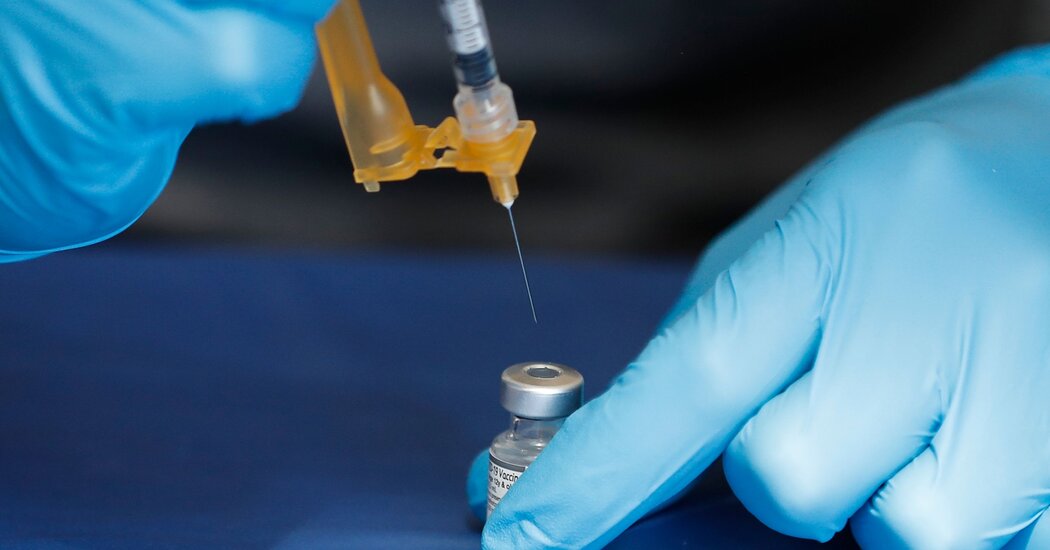
An expert committee recommended Tuesday that the Food and Drug Administration plan on an updated booster shot of the coronavirus vaccines that targets some form of the Omicron variant that has dominated for months.
The panel’s vote paves the way for F.D.A. regulators to push for a new formulation for shots that the Biden administration hopes to offer later this year, before an expected winter resurgence of the virus.
The committee debated but did not specify which formulation might work best. The F.D.A. appeared to be leaning strongly toward a combination of the existing vaccine and two subvariants of Omicron, known as BA.4 and BA.5. According to new estimates from the Centers for Disease Control and Prevention, those two subvariants together now make up more than half of new cases in the country.
Dr. Peter Marks, who oversees the F.D.A.’s vaccine division, said the regulators must recommend a specific formulation “very rapidly” if new shots are to be rolled out in the fall. Manufacturers of the mRNA vaccines, made by Moderna and Pfizer-BioNTech, require roughly three months to produce doses of a redesigned vaccine.
Clinical trial results on a combination of the so-called “prototype,” or existing, vaccines and Omicron itself have received mixed reviews so far. In briefing materials, regulators suggested that such a design is “already somewhat outdated.”
The panel struggled with what one member called “trying to predict the future” of where the virus is headed. Another panelist called the data “uncomfortably scant.” Some said the most impressive booster might be one proposed by Novavax, a company whose vaccine is not yet even available as initial doses in the United States.
Dr. Adam C. Berger, a National Institutes of Health official, said that while he supported an updated booster in theory, “I’m not sure that we have evidence to support a change necessarily today.”
But despite much hand-wringing, 19 on the 21 members on the panel ultimately voted in favor of an updated booster. “We’re all troubled by the steady erosion of immune protection,” Dr. Mark Sawyer, an infectious disease specialist at Rady Children’s Hospital in San Diego, said. “We’re going to be behind the eight ball if we wait longer.”
The panel seemed generally against switching the vaccine formulation for people who have not yet been fully vaccinated.
“I don’t think we should lose the prototype. I think it’s a known entity and it’s doing really well in its current job,” Dr. Amanda Cohn, a top C.D.C. official, said.
There was little talk about any variant other than Omicron, which has proved to be a global game-changer, dulling vaccine-induced protection and spawning even more wily forms of the virus with the power to reinfect people. Dr. Marks said figuring out how to counter the virus’s shifts was “science at its hardest.”
Dr. Jerry Weir, an F.D.A. official, said that forms of Omicron have dominated for about six months now and whatever form of the virus is circulating in the fall is more likely to be tied to the Omicron family than earlier versions of the virus.
Overall, he said, the data indicate that a booster that incorporates an Omicron component produces a better antibody response against that family and offers “the potential for improved vaccine effectiveness.”
Several committee members cautioned against holding out for more definitive data. Dr. Melinda Wharton, a C.D.C. vaccine specialist, said she was convinced that a booster aiming at some form of Omicron would increase the breadth of immunity, as an adviser to the World Health Organization suggested.
Members of the panel largely skirted the question of who should receive a new booster. Some have suggested that a fall booster will be broadly necessary, while others contend that because the current vaccines’ protection has held up against severe disease, the next round of shots should be limited to the elderly and high-risk individuals.
Although the overall death rate is low now compared to earlier in the pandemic, C.D.C. officials said Americans 70 and older have driven increases in hospitalizations. Heather Scobie, an agency epidemiologist, said that despite “rather poor” uptake, second boosters were reducing the risk of death in older adults.
Federal health officials have suggested for months that more advanced vaccines may be needed to combat the rapidly evolving virus, warning that vaccine-induced protection against infection has faded, allowing some Americans to be reinfected even in the span of several months.
In briefing materials, F.D.A. officials said the risk of another major outbreak will rise later this year “due to the combination of waning immunity, further evolution of variants, and increased indoor activity.”
Moderna and Pfizer, the makers of the two most widely-used vaccines in the United States, have both studied vaccines that target the first version of Omicron, expecting them to be seriously considered as the fall booster option. But the research has been complicated by the subvariants, for which neither company has developed shots yet. If the F.D.A. chooses a vaccine that targets BA.4 or BA.5, it is unclear whether either company will be able to study it and manufacture doses in time for a fall booster campaign.
Pfizer presented the only data on such a formulation — preliminary data from a mouse trial — suggesting it worked better against all Omicron’s subvariants than the existing vaccine does. But a company official said researchers do not yet have a side-by-side comparison with a version targeting Omicron itself.
